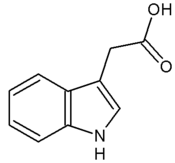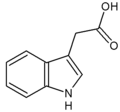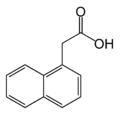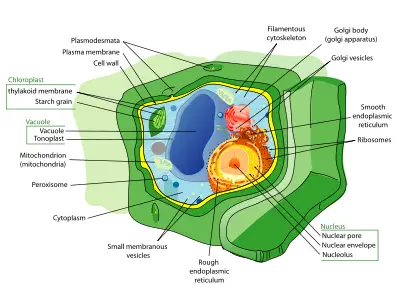Auxin
Auxins are a class of plant growth substance (often called phytohormones or plant hormones). Auxins play an essential role in coordination of many growth and behavioral processes in the plant life cycle.
Overview
Auxins have been demonstrated to be a basic coordinative signal of plant development. Their pattern of active transport through the plant is complex, and auxins typically act in concert with (or opposition to) other plant hormones. For example, the ratio of auxin to cytokinin in certain plant tissues determines initiation of root versus shoot buds. As a result, a plant can (as a whole) react on external conditions and adjust to them, without requiring a nervous system.
The most important member of the auxin family is indole-3-acetic acid (IAA). It generates the majority of auxin effects in intact plants, and is the most potent native auxin. However, molecules of IAA are chemically labile in aqueous solution, so IAA cannot be applied commercially as a plant growth regulator.
- Naturally-occurring auxins include 4-chloro-indoleacetic acid, phenylacetic acid (PAA) and indole-3-butyric acid (IBA).
- Synthetic auxin analogs include 1-naphthaleneacetic acid (NAA), 2,4-dichlorophenoxyacetic acid (2,4-D), and others.
Gallery of native auxins
- Indolebutyric acid.png
IAA; IBA; PAA
Gallery of synthetic auxins
1-NAA, 2,4-D; 2,4,5-T
Auxins are often used to promote initiation of root growth and are the active ingredient of the commercial preparations used in horticulture to root stem cuttings). They can also be used to promote uniform flowering, to promote fruit set, and to prevent premature fruit drop.
Used in high doses, auxin stimulates the production of ethylene. Excess ethylene can inhibit elongation growth, cause leaves to fall (leaf abscission), and even kill the plant. Some synthetic auxins such as 2,4-D and 2,4,5-trichlorophenoxyacetic acid (2,4,5-T) can be used as herbicides. Broad-leaf plants (dicots) such as dandelions are much more susceptible to auxins than narrow-leaf plants (monocots) like grass and cereal crops.
Hormonal activity
Auxins coordinate development at all levels of plants, from the cellular level to organs and ultimately the whole plant.
Molecular mechanisms
Although auxins and their effects have been known for a long time, molecular mechanisms of action have been difficult subjects.
Auxins directly stimulate or inhibit the expression of specific genes. Auxin induces transcription by targeting for degradation members of the Aux/IAA family of transcriptional repressor proteins, The degradation of the Aux/IAAs leads to the derepression of ARF-mediated transcription. Aux/IAAs are targeted for degradation by ubiquitination, catalysed by an SCF-type ubiquitin-protein ligase.
In 2005, it was demonstrated that the F-box protein TIR1, which is part of the ubiquitin ligase complex SCFTIR1, is an auxin receptor. Upon auxin binding TIR1 recruits specific transcriptional repressors (the Aux/IAA repressors) for ubiquitination by the SCF complex. This marking process leads to the degradation of the repressors by the proteasome, alleviating repression and leading to specific gene expression in response to auxins.
Another protein called ABP1 (Auxin Binding Protein 1) is a putative receptor, but its role is unclear. Electrophysiological experiments with protoplasts and anti-ABP1 antibodies suggest that ABP1 may have a function at the plasma membrane.
On a cellular level
On the cellular level, auxin is essential for cell growth, affecting both cell division and cellular expansion. Depending on the specific tissue, auxin may promote axial elongation (as in shoots), lateral expansion (as in root swelling), or isodiametric expansion (as in fruit growth). In some cases (coleoptile growth) auxin-promoted cellular expansion occurs in the absence of cell division. In other cases, auxin-promoted cell division and cell expansion may be closely sequenced within the same tissue (root initiation, fruit growth). In a living plant it appears that that auxins and other plant hormones nearly always interact to determine patterns of plant development.
According to the "acid growth theory," auxins may directly stimulate the early phases of cell elongation by causing responsive cells to actively transport hydrogen ions out of the cell, thus lowering the pH around cells. This acidification of the cell wall region activates enzymes known as expansins, which break bonds in the cell wall structure, making the cell wall less rigid. When the cell wall is degraded (not entirely) by the action of auxins, this now-less-rigid wall is expanded by the pressure coming from within the cell, especially by growing vacuoles.
However, the acid growth theory does not by itself account for the increased synthesis and transport of cell wall precursors and secretory activity in the Golgi system that accomplany and sustain auxin-promoted cell expansion.
Organ patterns
Growth and division of plant cells together result in growth of tissue, and specific tissue growth contributes to the development of plant organs. Growth of cells contributes to the plant's size, but uneven localized growth produces bending, turning and directionalization of organs, for example, stems turning toward light sources (phototropism), growth of roots in response to gravity (gravitropism), and other tropisms.
Organization of the plant
As auxins contribute to organ shaping, they are also fundamentally required for proper development of the plant itself. Without hormonal regulation and organization, plants would be merely proliferating heaps of similar cells. Auxin employment begins in the embryo of the plant, where directional distribution of auxin ushers in subsequent growth and development of primary growth poles, then forms buds of future organs. Throughout the plant's life, auxin helps the plant maintain the polarity of growth and recognize where it has its branches (or any organ) connected.
An important principle of plant organization based upon auxin distribution is apical dominance, which means that the auxin produced by the apical bud (or growing tip) diffuses downwards and inhibits the development of ulterior lateral bud growth, which would otherwise compete with the apical tip for light and nutrients. Removing the apical tip and its suppressive hormone allows the lower dormant lateral buds to develop, and the buds between the leaf stalk and stem produce new shoots which compete to become the lead growth. This behavior is used in pruning by horticulturists.
Uneven distribution of auxin: To cause growth in the required domains, it is necessary that auxins be active preferentially in them. Auxins are not synthesized everywhere, but each cell retains the potential ability to do so, and only under specific conditions will auxin synthesis be activated. For that purpose, not only do auxins have to be translocated toward those sites where they are needed but there has to be an established mechanism to detect those sites. Translocation is driven throughout the plant body primarily from peaks of shoots to peaks of roots. For long distances, relocation occurs via the stream of fluid in phloem vessels, but, for short-distance transport, a unique system of coordinated polar transport directly from cell to cell is exploited. This process of polar auxin transport is directional and very strictly regulated. It is based in uneven distribution of auxin efflux carriers on the plasma membrane, which send auxins in the proper direction.
A 2006 study showed plant-specific pin-formed (PIN) proteins are vital in transporting auxin. PINs also regulate auxin efflux from mammalian and yeast cells.[1]
Locations
- Synthesized in shoot (and root) meristematic tissue
- Synthesized in young leaves
- Synthesized in mature leaves in very tiny amounts
- Synthesized in mature root cells in even smaller amounts (speculative)
- Transported throughout the plant more prominently downward from the shoot apices
- Released by meristematic cells when they are in good growing conditions
- Released by all cells when they are experiencing conditions that would normally cause a shoot meristematic cell to produce auxin (speculative)
- Directly or indirectly induced by high levels of ethylene (speculative)
- Peaks during the day
Effects
- Stimulates cell elongation (if gibberellins are also present, the effect is stronger)
- Stimulates cell division (if cytokinins are also present)
- Induces formation and organization of phloem (and xylem)
- Participates in phototropism, geotropism, hydrotropism and other developmental changes
- Induces new root formation by breaking root apical dominance induced by cytokinins
- Induces shoot apical dominance
- Directly stimulates ethylene synthesis (stimulation of ethylene in lateral buds causes inhibition of its growth and potentiation of apical dominance)
- Inhibits (in low amounts) ethylene formation and transport of precursor
- Inhibits abscission prior to formation of abscission layer (inhibits senescence of leaves)
- Induces sugar and mineral accumulation at the site of application
- Stimulates Flower initiation
- Is sex determinator
- Inhibits root hair growth and causes them to die back (speculative)
- Stimulates the rate of metabolism of cells in the root, thus increasing their efficiency of water and mineral uptake(speculative)
- Indicates when cells have more than enough sugar and gases available than are needed for existence at their present size. It is a shoot health indicator and growth signal, and one of its essential missions is to compliment the excess sugar and gases with an excess of root-derived water and minerals. It therefore induces new roots. If Cytokinin is present, this is an indication that the root is healthy and the plant is completely ready to grow. In this case, it simply cooperates with cytokinin to cause cell division and balanced plant growth. (speculative)
- Appears in general to be induced at the site of high concentrations of sugar, but always moving in a direction away from this synthesis. Since Auxin attracts nutrients to the cell where it is, this transport of auxin away from sugar synthesis may partly explain the transport of sugar in the phloem to the roots. The sugar may just be following the auxin. (speculative)
Herbicide manufacture
The defoliant Agent Orange was a mix of 2,4-D and 2,4,5-T. 2,4-D is still in use and is thought to be safe, but 2,4,5-T was more or less banned by the EPA in 1979. The dioxin TCDD is an unavoidable contaminant produced in the manufacture of 2,4,5-T. As a result of the integral dioxin contamination, 2,4,5-T has been implicated in leukaemia, miscarriages, birth defects, liver damage, and other diseases.
See also
- Herbicide
- Pruning fruit trees
Sources
Plant Physiology Online - Chapter 19: Auxin: The Growth Hormone
| Plant hormones | edit |
|
Abscisic acid - Auxins - Cytokinins - Ethylene (Ethene) - Gibberellins Brassinosteroids - Jasmonates - Salicylic acid |
Credits
New World Encyclopedia writers and editors rewrote and completed the Wikipedia article in accordance with New World Encyclopedia standards. This article abides by terms of the Creative Commons CC-by-sa 3.0 License (CC-by-sa), which may be used and disseminated with proper attribution. Credit is due under the terms of this license that can reference both the New World Encyclopedia contributors and the selfless volunteer contributors of the Wikimedia Foundation. To cite this article click here for a list of acceptable citing formats.The history of earlier contributions by wikipedians is accessible to researchers here:
The history of this article since it was imported to New World Encyclopedia:
Note: Some restrictions may apply to use of individual images which are separately licensed.






